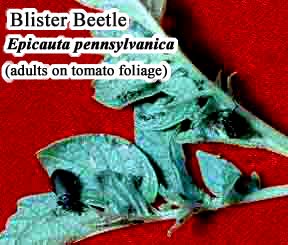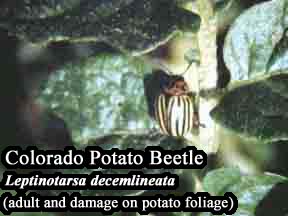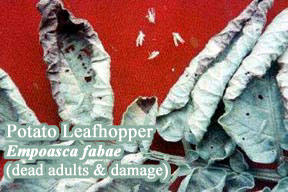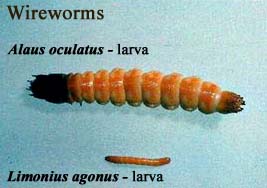Potato (Solanum)
Plant Health Problems
Injury from a disease may be seen in seed tubers, in the field, and later in harvested tubers. However, each disease is characterized by the season in which the grower finds it causing severe damage. Diseases are here listed under the season in which they are generally first noticed.
Diseases present in seed tubers:
Diseases caused by Fungi:
Dry rot, Fusarium sp. and Phytophthora infestans.
Dry rot is caused by pink, yellow, white, or gray fungi that can be seen in cavities in tubers. Rotting seed pieces in the field cause missing hills.
Frequent sterilization of knives (10% bleach solution) used in cutting seed tubers will stop the spread of this pathogen. Treating seed by dipping in a fungicide prevents spread during cutting and planting. Among the compounds registered for use in Connecticut are copper and maneb+mancozeb. Consult the label for dosage rates and safety precautions.
Diseases caused by Bacteria:
Soft rot, Erwinia carotova var. atroseptica. Soft rot is caused by bacteria that break tubers down in a soft, slimy, stinking decay. Rot organisms are present in seed and soil, but they enter only injured tubers. Decaying seed and low, wet soil decrease stands. Infection may spread to new shoots causing Blackleg.
Whole seed or cut seed healed before planting improves stands. Frequent sterilization of knives (10% bleach solution) used in cutting seed tubers will stop the spread of this pathogen.
Blackleg, Erwinia carotova var. atroseptica. Bacteria cause an inky-black, soft rot spreading from the stem-end of tubers to the interior. In the field, diseased plants become erect and the young leaves curl. Later, stems at the soil line become slimy and black, and decaying tubers are produced. Blackleg bacteria are carried in seed tubers and possibly are present in soil. Decaying seed and low-lying, wet soil increase losses.
During cold weather, planting whole seed or cut seed healed before planting has been shown to be helpful. Cut seed can be healed or "suberized" by holding at 60 to 70 F and about 85% relative humidity, with adequate ventilation, for about a week. See Soft rot.
Ring rot or bacterial wilt, Corynebacterium sepedonicum. Bacteria rot out the vascular ring which is located about one-eighth of an inch beneath the skin of the tuber. At first the rest of the tuber is sound, and cheesy ribbons can be squeezed from the ring of a cut, diseased tuber. Later the interior of the tuber rots, leaving a shell of firm tissue. In the field diseased plants wilt during August, drop their leaves, and die. Diseased tubers are produced. Ring rot bacteria are carried in seed. The bacteria are highly infectious and spread rapidly during cutting and planting.
Frequent sterilization of knives (10% bleach solution) used in cutting seed tubers will stop the spread of this pathogen. The use of clean certified seed virtually eliminates this problem.
Diseases in the Field:
Diseases caused by Fungi:
Late blight, Phytophthora infestans.
Late blight becomes epidemic during cool, wet weather when the fungus can produce spores and infect additional leaves nearby. Symptoms appear on leaves 5 to 7 days after a rainy period as pale green, moist areas. In wet weather, the areas increase in size overnight, the centers die, and a ring of white mildew appears on the lower side of the leaf around dead areas. Under favorable conditions the entire plant may be killed. Severely blighted fields have a distinct odor of decaying plants. The fungus from blighted foliage can also infect tubers. The resulting decay is firm and brown, spreading inward from the surface. Other microorganisms enter the decaying tissue, and both dry and soft rots develop. During cool, wet weather the late blight fungus is carried from shoot to shoot through the air, rain, and from shoot to tuber by contact. Cull piles can be a source of spores if they are not destroyed.
Among the compounds registered for use in Connecticut are metalaxyl, chlorothalonil, maneb, and mancozeb. Consult the label for dosage rates and safety precautions. If vines are killed several days before digging, tuber infection is decreased. If tuber decay is found, its development will be slower if the storage is cooled rapidly to 40 F.
Early blight, Alternaria solani.
Fungus spreads to leaves through the air during warm, wet weather. Symptoms appear as brown spots that may enlarge to one-half inch in diameter. Each large spot shows a series of concentric rings, giving it the appearance of a target. Later the fungus can spread to tubers, where it causes shallow decay. Early defoliation, however, is the most serious damage. Early blight fungus spreads in much the same way as the late blight fungus. However, early blight is favored by warm weather, late blight by cool, wet weather.
Among the compounds registered for use in Connecticut are chlorothalonil, maneb, and mancozeb. Consult the label for dosage rates and safety precautions.
Verticillium wilt (Early dying disease), Verticillium dahliae.
This wilt, which has become general in Connecticut fields, is most evident in late August and September. Lower leaves become yellow and die, and the denuded stem holds up a flag of wilted upper leaves. The inside of the stem is discolored. The vascular ring may be discolored at the stem-end of the tuber. Verticillium is carried in seed and soil and infects the plant beneath the ground. Seed from severely infected fields increases infection.
Extended rotations (>5 years) seem to give some benefit.
Rhizoctonia (Black scurf), Rhizoctonia solani. This fungus attacks the plant beneath the ground and in severe infections kills sprout before they reach the surface. More commonly it produces rusty-brown lesions on the underground main stem and white mold on the stem just above the soil line. The number of tubers may be increased and their size decreased. Black, thin bodies (black scurf) are found stuck tightly to the tubers, especially when tubers are washed. Rhizoctonia is present on seed and in soil, infecting a wide variety of plants. Seed with a great deal of black scurf increases infection.
Crop rotation is the best control.
Diseases caused by Viruses:
Viruses and viroids.
Potatoes are susceptible to several viruses causing mosaic or leaf distortion and mottling, leaf roll, yellow and purple top, and "spindle tubers." Viruses are carried in the seed from season to season. In the field they are generally spread by aphids or leafhoppers.
If clean seed is used, little infection will occur. Early control of insects can be used to prevent spread in the field, especially if seed is to be saved.
Diseases of harvested tubers:
Diseases caused by Bacteria:
Common scab, Streptomyces scabies.
Scab is caused by a soilborne bacterium that infects tubers and produces russetted areas or small, brown spots that later become large, corky pits. Scab is most severe in soils of neutral or alkaline reaction. Seed tubers infected with the scab bacterium increase the amount of fungus in the soil.
There are a number of scab resistant potato cultivars.
Diseases caused by Physiological/Environmental Factors:
Hollow heart
Hollow-heart potatoes are large, overgrown tubers with star shaped hollow areas in the centers. Proper plant separation and even watering and fertilization all help to prevent hollow heart.
Blackheart
Blackheart is caused by too high temperatures in storage and, hence, insufficient oxygen in the center of the tuber.
Off-shape tubers and growth cracks
Off-shape tubers and growth cracks occur in certain varieties, for example Green Mountain and Russet Burbank, due to uneven growing conditions.
Jelly-end rot
Jelly-end rot appears at the tips of off-shape tubers, caused by irregular watering.
Enlarged lenticels
Enlarged lenticels or "pores" are caused by excessive soil moisture before harvest. Tubers cooled below 29 F show net necrosis or dark blotching of the internal tissue and lack firmness.
Insect Problems:
 Blister beetles, Family Meloidae.
Blister beetles, Family Meloidae.
Several species of blister beetles feed upon potato. Control is not usually necessary.
 Colorado potato beetle, Leptinotarsa decemlineata.
Colorado potato beetle, Leptinotarsa decemlineata.
Both larvae and adults feed upon the leaves, and there are two generations yearly. The insects hibernate as adults under rubbish or in the soil, and they emerge and feed upon the first potato shoots that appear. Later, the females lay clusters of yellow eggs on the undersides of the leaves. These eggs hatch and the larvae or grubs begin at once to devour the leaves. The grubs are strongly convex and dark red with a black head and two rows of black spots on each side. In the last larval stage, the red is somewhat lighter in color, and the grub is ½"or slightly more in length. The beetle is also strongly convex, yellow with longitudinal black stripes, and is about 3/8" long. Each wingcover has five stripes, and the thorax has two somewhat diamond-shaped black spots in the center and from four to six small spots on either side. See Colorado Potato Beetle fact sheet.
Cutworms.
Ordinary cutworms may be a problem in a few potato fields. They cut off new growth and may possibly damage young tubers. Treatment to control them is usually unnecessary. See Cutworm fact sheet.
European corn borer.
The larvae of this insect tunnels in potato stalks. The openings made in the stalk provide entrance for disease organisms. European corn borer infestations of potato are more likely near fields planted with corn in the previous year when stalks were not plowed down at the end of the season. Early plantings of corn may lure ovipositing moths away and may reduce the infestation on potato. Some potato varieties, such as Sebago, Monona, Norgold, Norchip, and Norkota, are particularly susceptible to European corn borer. This insect feeds not only on potato, but also on other crops, many weeds, and on a variety of other herbaceous plants. The larvae tunnel in the stems, weakening them so they break. The larva is pale white or gray with black tubercles and is not more than 1" long when fully grown. Adults have a wingspread of 1" or so and are buff to brown colored. There are usually two generations each year. Eggs are laid on the underside of leaves and the larvae tunnel in the stems and pupate in the burrows. Second generation larvae and those of the single generation corn borer overwinter in the stems and pupate in the spring.
Control begins with tillage of crop residue, either in the fall or early in the spring. This reduces the survival of borers from the previous year. Pheromone traps may be used to monitor adult activity. Bacillus thuringiensis var. kurstaki is among the compounds registered for control of European corn borer in Connecticut, but to be effective, it must be applied before the larvae enter the potato stem. Consult the label for dosage rates, safety precautions, and preharvest intervals. Applications may be needed when caterpillars or signs of feeding damage are visible, or when pheromone traps indicate the flight of adults.
The parasitic wasp Trichogramma has been used as alternative method of control. This tiny wasp attacks the egg masses of the corn borer, as well as eggs of other caterpillars. Be sure to purchase the insects from a reputable supplier and make sure the strain you purchase is known to be well adapted to attacking corn borer. Bt will not harm the Trichogramma wasps, but other insecticides will.
Fourlined plant bug, Poecilocapsus lineatus.
This bug sometimes injures potato. No special control is required.
Mottled tortoise beetle, Deloyala guttata.
This beetle, with a dark, central teddy-bear-shaped marking on a reddish-gold background, does not usually require control.
Potato aphids.
Three species of aphids commonly infest potatoes in Connecticut. These are the green peach aphid, Myzus persicae, the potato aphid, Macrosiphum euphorbiae, and the buckthorn aphid, Aphis nasturtii. All three species normally pass the winter as glossy oval black eggs. The green peach aphid overwinters on peach trees, the potato aphid on roses, and the buckthorn aphid on buckthorn. The eggs hatch in the spring when the leaf buds first unfold. The aphids live on these hosts for two or three generations and then migrate to potato and other herbaceous plants. Although the infestation usually does not become noticeable in Connecticut until July, aphids are usually present in small numbers on the plants in June. If potato virus diseases are present, these aphids will spread the viruses in the field, and insecticides are not effective in stopping the spread. In the absence of chemical insecticides, aphids do not reach high enough numbers to do direct damage because they are usually controlled by their natural enemies. See Aphid fact sheet.
Potato flea beetle, Epitrix cucumeris.
This is a small, black, jumping flea beetle that feeds upon the leaves of potato, tomato, tobacco, and many other plants, eating out small round holes from the underside, but leaving the upper epidermis. The remaining tissue soon dies, however, and falls away, leaving holes through the leaves which turn yellow and later turn brown and die. This beetle is not much more than 1/16" long. It lives through the winter under rubbish and in other sheltered places, and may first be found in the spring on plantain and other weeds, sometimes also on the leaves of apple, wild cherry, and maple. As soon as the preferred food such as potato and tomato plants appear in the garden or field, the flea beetles gather upon them. The overwintering beetles lay eggs in the soil in June. The larvae feed upon tubers and roots of the host plants. An abnormal growth sometimes takes place around each injury, causing scurfy and pimply potatoes. The larvae pupate and beetles emerge early in July.
These beetles feed on the potato foliage as long as the plants are green and temperatures are favorable. These insects then hibernate until the following spring. If the flea beetles are controlled in the spring when they first begin feeding, fewer beetles will be present in the fall and the following spring. See Flea Beetle fact sheet.
 Potato leafhopper, Empoasca fabae.
Potato leafhopper, Empoasca fabae.
This insect is a serious pest in some years in Connecticut. It does not overwinter here, and the severity of infestation depends on the size of the migrating population and the weather. In addition to being a pest of potatoes, it is also a pest of beans and alfalfa, and probably moves into potatoes after multiplying on other host plants. The adult is about 1/8" long and yellowish green. Nymphs are similar in color but have no wings. Both adults and nymphs are difficult to see because they move rapidly. Adults and nymphs may infest potatoes and cause injury by sucking sap from the bottom side of leaves. This causes the young leaves to curl or gives them a white peppered appearance. Continued feeding results in a yellowing or browning of the leaves, called "hopperburn." Potatoes are very sensitive to leafhopper damage, and yield may be reduced before damage is visible. Early-maturing varieties are more susceptible to damage than later varieties. The varieties Elba and NY L-235-4 are specifically resistant to leafhoppers, and NY L-235-4 is resistant to aphids and to some extent to Colorado potato beetles, too. Among the compounds registered for control of this pest in Connecticut are pyrethrum, rotenone, or carbaryl. Repeated use of insecticides may lead to outbreaks of aphids. Consult the labels for dosage rates and safety precautions.
Potato stalk borer, Trichobaris trinotata.
The larvae of this snout beetle may be found boring in stalks. It has not been a serious pest and no control measures have been required.
Stalk borer, Papaipema nebris.
The stalk borer sometimes tunnels in potato stalks. This borer infests an occasional stalk of many kinds of herbaceous plants. As a rule its presence escapes notice until the plant begins to wilt. Then it is too late for the plant to recover. The larva tunnels up and down inside the stem and the top portion usually wilts and later dies. There is one generation each year. The moths emerge in September and October and lay eggs on the stems of their food plants, in which stage the insect passes the winter. The eggs hatch in May or early June. The young larva begins to feed on the leaves of the nearest food plant, and later tunnels in the stem. The mature larva is nearly 1 1/2" long, grayish brown with one white dorsal stripe and two white lateral stripes on each side. On the front half of the body the lateral stripes are interrupted, and the lower brown stripe extends forward onto the side of the head.
Burning all crop residues, if allowed, and destroying weeds at the edges of the garden helps control this insect. When needed, methoxychlor, which is among the compounds registered for use against this pest in Connecticut, applied as a dust, in June, should control this pest. Consult the label for dosage rates, safety precautions and preharvest intervals.
Threelined potato beetle, Lema trilinea.
This is a reddish yellow beetle, about ¼" long, with three black stripes running lengthwise on the wingcovers. This beetle probably hibernates as an adult and there may be two generations per year. The beetles appear when potato and tomato plants are growing in the field and lay their small clusters of yellow eggs on the undersides of the leaves. The yellow larvae feed side by side and move backward from the leaf margin as they devour the leaf tissue. They carry a coating of brown excrement on their backs. The larvae become full grown in about two weeks, when they are about 1/3" long, and enter the ground to pupate. Among the compounds registered for control of this pest in Connecticut are rotenone, pyrethrum, or carbaryl. Consult the labels for dosage rates, safety precautions, and preharvest intervals.
White grubs.
White grubs often cause severe injury by eating the tubers. They are most common in land recently in sod. Usually the damage is discovered too late for control.
 Wireworms.
Wireworms.
Shiny, hard-shelled wireworms sometimes damage potatoes by tunneling into seed pieces, roots, stems, and new tubers. Potatoes following sod may be damaged by larvae of the corn wireworm, Melanotus communis, or the wheat wireworm, Agriotes mancus. These usually occur in the heavier potato soils and tend to disappear with continued cultivation. Larvae of the eastern field wireworm, Limonius agonus, may damage potatoes planted continuously in light sandy soils. Continued cultivation encourages this species. Fields found infested after growth has begun may be harvested as early as practical to avoid further damage. The presence of wireworms in soil may be detected with baits, such as a cut potato, a mixture of untreated wheat and corn seeds, or rolled oats, buried a few inches deep in the soil, marked with a flag, then dug up 2-3 weeks later. If present in large numbers, they may also be visible when the soil is turned over.
Wireworms are difficult to control with available insecticides. Some tactics which may reduce damage are: 1) delay planting for several weeks after plowing so that little food is available, 2) use plastic mulch between rows to heat the soil above the wireworms' preferred temperature.

